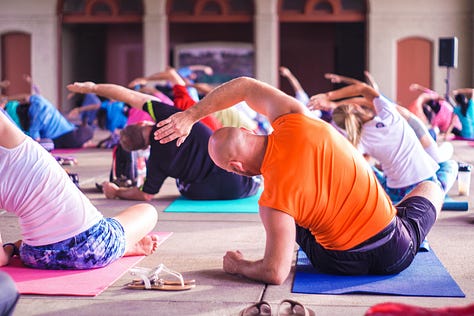A powerful medicine for the mind
Plus, Pivot Triggers and announcing the winner of the reader survey.
Hello, creatives!
I hope you're having a great start to your week. This week I became curious about the link between exercising and mental health. It’s quite interesting to see the changes that happen within our body and mind from just a short exercise session.
With all the layoffs in tech, this is a good time to remind ourselves that we can get through this challenging time by taking care of our physical and, more importantly, mental health through exercise.
Reach out if you need to talk; I’m here for you.
On to this week’s post!






The most powerful medicine for the mind
Running saved my life.
The first time was when I started running to quit smoking. I had been smoking for about ten years and had tried quitting unsuccessfully many times. Running had the most promising results. As I continued running, it helped eliminate the cravings for smoking, and I had a powerful antidote to a negative habit that would make life even worse for me had I continued.
Running is saving my life again.
Now I run for my mental health because it helps me relieve stress, improves my mood, helps me think clearly, and gives me the confidence I need to tackle the day ahead of me. Running is my drug of choice.
I recently read about how a single exercise can help improve feelings of depression and learned that even a 20-minute exercise session could be beneficial. Keeping this in mind can help us exercise more often, increase motivation, and improve our mental health.
Dangers of a Sedentary Lifestyle
Working from home during the pandemic has made it easier to sit at our desks all day instead of taking the time out to exercise, but we need to make exercise a priority to protect our mental health.
Physical inactivity is also the cause of most chronic diseases. the body rapidly maladapts to insufficient physical activity, and if continued, results in substantial decreases in both total and quality years of life.1
Some of the dangers of inactivity are:
Gaining weight
Losing muscle strength
Weakened immune system
Bad posture
Backaches
Inactivity affects our mood and sense of control, which can push us into a downward spiral if left unchecked.
But we can fight back with exercise!
The powerful benefits of exercise
We know the physical benefits exercise has on weight control, blood pressure, and increased energy,2 but what benefits does exercise have on our mental health?
There are many well-established benefits, such as:
Improved cognitive function
Reduced anxiety and depression
Improved sleep
Lowered stress
Clarity of thought
Improved self-esteem
But how exactly does exercise help?
Let's look at the physiological functions that take place within the body effects of exercise:
The core body temperature rises, which helps to release muscle tension, which improves mood. (Thermogenic Hypothesis) 3
Through the increased release of endorphins.[^1] Endorphines are one of several substances made in the body that can relieve pain and give a feeling of well-being. (Endorphine Hypothesis)
Exercise increases the availability of brain neurotransmitters, such as serotonin, dopamine, and norepinephrine, which may lessen because of depression. (Monoamine Hypothesis)
Physical activity helps to distract us from worries, anxiety, and negative thoughts. (Distraction Hypothesis)
Gaining the belief that we have the skills necessary to complete a task and gaining the confidence that we can complete a task with the desired outcome resulting in a positive outcome. (Self-Efficacy Hypothesis)
Knowing how our body responds to exercise and how that translates to improved mental health helps make things clear to us so we can understand the connection between the two.
"If exercise could be packed into a pill, it would be the single most widely prescribed, and beneficial, medicine in the nation."
- Robert N. Butler MD
Hopefully, you're convinced of the positive link between exercise and mental health and why you should exercise more. So how do you get started?
Here are some things to think about before you start exercising.
Start small - Build up your activity levels gradually. Even a 20-minute activity can provide mood-boosting results. At this point focus on becoming comfortable with your new habit and schedule.
Focus on consistency - In the beginning, focus on exercising regularly so you develop the habit and it becomes a part of you. Once you are able to exercise regularly you can begin adding more days or increase the your exercise time.
Technology can help - There are many apps you can use to track your exercising and progress which helps to boost your motivation for exercising.
Take part in challenges - Challenges bring an element of competition which helps provide the right motivation needed to exercise consistently and to make it fun.
Join a community - Exercising with a group, whether it’s at a gym or a running club, can help you stay focused, provide support, add accountability, and provide the extra motivation you will need to keep exercising regularly. You can also subscribe to a newsletter focused on running, such as @TheHalfMarathoner, by
in which he shares running inspiration and weekly community discussions on running.Make Exercising Great Again!
We've been through a lot in the past few years, and our physical and mental health have suffered, but by getting back to exercising or even starting for the first time right now, we can undo the damage and begin healing our bodies our minds.
Having a bad day? Go exercise!
Anxious about your work? Go exercise!
Worried about Twitterpocalypse? Go exercise!
I have managed my stress, released negative thoughts, and improved my mood through running. Whether you like to exercise by walking, running, biking, working out, or any other type of activity, the important thing is to get moving. Even a 20-minute session is better than nothing to keep your mind healthy and sharp.
What benefits do you experience when you exercise?
New Idea: Pivot Triggers
Pivot Triggers are the signals we decide on before starting a project for us to keep investing time and energy in the project.
Or, asTom Kerwin explains:
“Most people think you need to agree on a vision and have the answers before you can be successful. It's actually the other way round.
The Pivot Triggers Methodology is a proven set of workshops and tools that help teams take effective action today so they can see the signals they need to make progress.”
My take:
I love the idea of pivot triggers, and if we combine them with an experimentation mindset, we can become even more flexible in our work and personal projects.
Before starting a project, we can identify the triggers to help us decide if we need to pivot or continue investing our time, effort, and attention. Instead of waiting too long, we can decide on the triggers to remind us to evaluate our progress along the way. The possibilities of applying the pivot trigger methodology are endless, such as:
Starting an exercise routine
Building a new habit
A project at home or at work
Learn more about the Pivot Triggers methodology
Join the conversation: What does your wind-down ritual look like?
A wind-down ritual is a set of actions we take at the end of the day. It's a gentle way to let your mind and body know to transition toward going to sleep. This is also a time to cherish precious moments away from devices and technology.
🎉 And the survey winner is…
Thanks to everyone who shared their feedback in the latest reader survey. The overall message was "You do you!" which makes me happy to keep sharing my experience and insights I gained along the way.
The $25 Starbucks gift card winner was...drum roll, please...Kim Witten! Congratulations, and thanks for your feedback!
I’ll keep the survey open if you have a few minutes, and would like to share your thoughts on this newsletter.
That’s it for this week. May you have a wonderful rest of your week!
Till next time, stay strong!
Rizwan 💜



